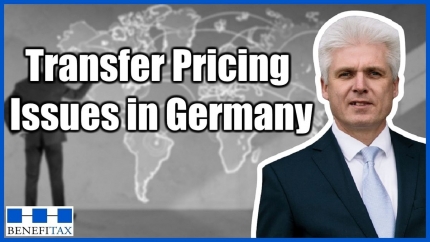Transfer Prices
Why should you pay attention at transfer prices?
It is important to pay attention to transfer prices (TP). Incorrect TP, their documentation or lacking cooperation in providing information to the tax authorities can lead to very unpleasant consequences.
– Tax arrears payments by estimates of the tax office
– Reversal of the burden of proof
– Interest on back tax payments for previous years
– Surcharge/fines of up to millions of Euros.
All companies exchanging goods or services with affiliated companies across the border should ensure that they are adequately remunerated. To this end, the conditions must be negotiated in advance by the parties involved as between third parties. If necessary, they must be recorded in a contract and in a separate documentation. We will be happy to support you in this.

Transfer pricing
Please find here our video about Transfer Pricing Issues in Germany:

Please accept YouTube cookies to play this video. By accepting you will be accessing content from YouTube, a service provided by an external third party.
If you accept this notice, your choice will be saved and the page will refresh.
Our services in the field of transfer pricing in international tax law
Checking of transfer pricing obligations of internationally operating companies
Does your German company have a parent or sister company, a subsidiary or permanent establishment abroad? If so, you should check at the beginning of each financial year whether you are obliged to prepare TP documentation. We will be happy to check this for you and tell you within what time limits it may have to be drawn up and what it should look like. We have compiled some basic information on transfer pricing documentation for you here. Even if you are not obliged to do so, you should prepare how to prove to the tax office that your transfer prices are at arm’s length.
Preparation of your transfer pricing documentation
We will be happy to prepare your TP documentation for you. It is often overlooked that TP documentation prepared under foreign law or in a foreign language is usually rejected by the German tax authorities. Applications must be submitted in good time.
Whether Local File, Master File or Country-by-Country Reporting (CBCR), we can help. TP documentation includes two parts: Firstly factual documentation: who in the group has what relationships with whom and to what extent. Secondly, documentation of appropriateness : the prices selected correspond to what third parties would have agreed. Various transfer pricing methods can be considered, which we have listed for you here.
Please note that the cost-plus method is simple, but not always allowed and a more sophisticated method like TNMM may have to be used. Depending on the TP method chosen, the proof must be provided in different ways. Since suitable external data is not always available, paid databases must sometimes be used for benchmarking. To ensure that you are on the safe side, we use the Amadeus database, which is also used by the German tax authorities.
Checking your transfer pricing documentation if the tax audit has already been announced
If you are unsure whether the transfer pricing documentation prepared by you or your tax advisor meets the requirements of the tax authorities, we will be happy to check it for you. If something is missing, we will supplement the missing parts or create a completely new documentation. This can save a lot of money, especially if a transfer pricing documentation is prepared for the first time, extraordinary business transactions such as the conclusion of a new intra-group agreement or the establishment, change or closure of business areas have occurred.
Support during tax audits, in particular when a specialist auditor is called in for foreign matters.
If your normal tax advisor is no longer capable of helping you, you are most welcome to consult us as specialists in international tax law. This sometimes happens, when in the course of a tax audit, questions are asked about international issues or transfer prices. This is particularly the case when a specialist auditor for foreign matters is called in during an ongoing tax audit or if a lot of money is involved.
On request, we only deal with tricky international tax issues and do not interfere in discussions about other findings and questions of the tax audit which your “house and court tax consultant” has under control. In this case, our specialist advisors in international taxation or tax professors are almost exclusively active, who can adequately stand up to the expert tax auditor. Click here for more information regarding audits.
